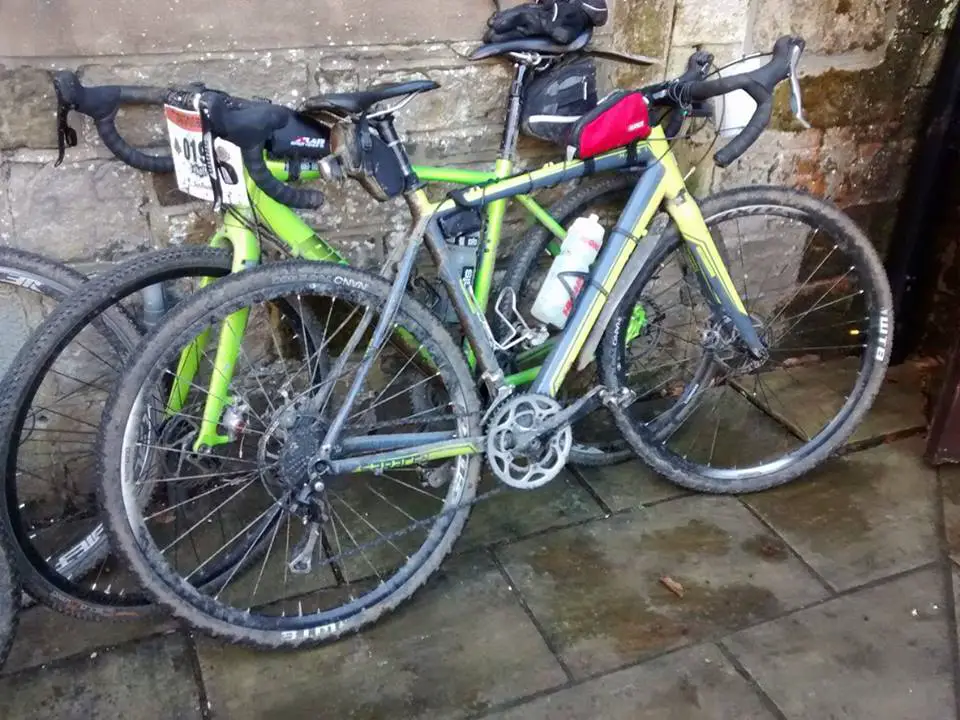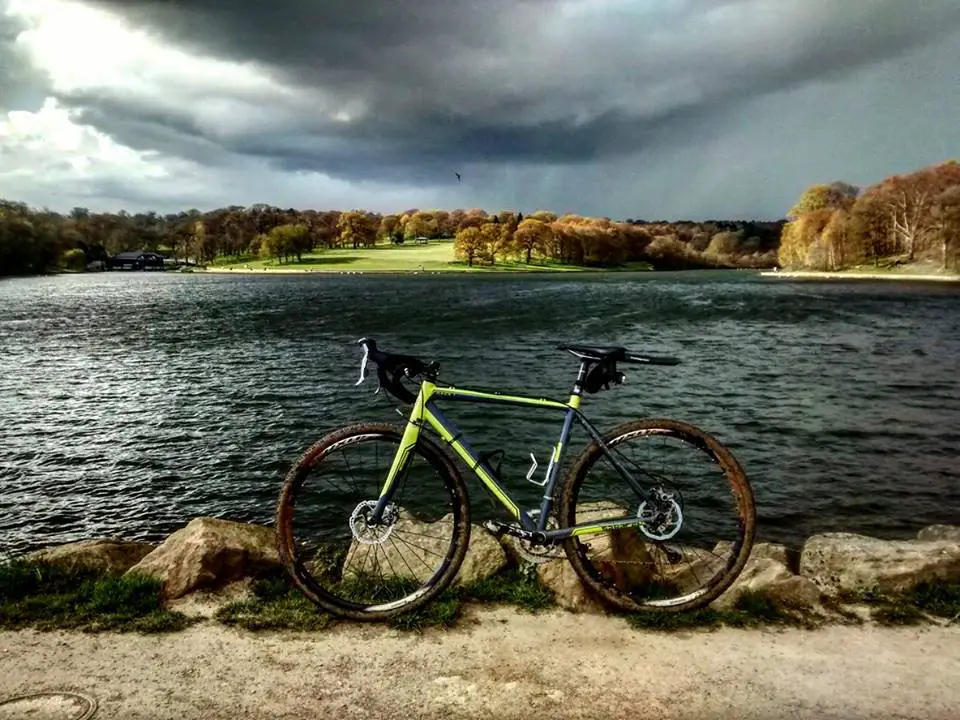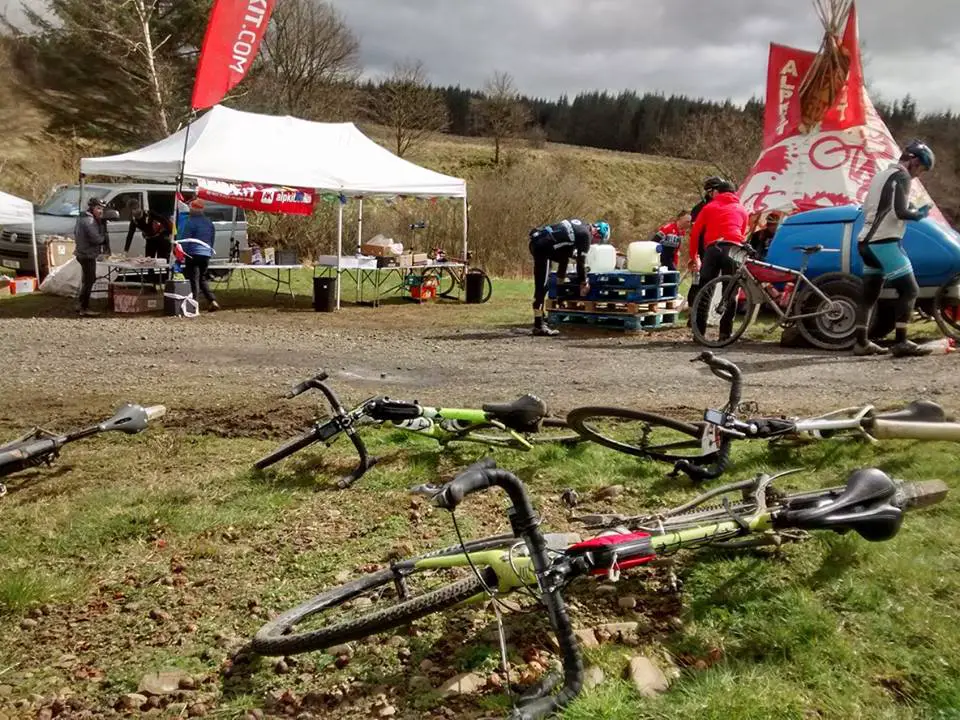They keep on coming… Kevin and Ben had a bit of an epic. Over to Kevin Harley-Roberts for the full lowdown.

Starting with the aftermath
“What the F***’s happened to my toes?!” Ben’s first utterance as we awoke, bleary-eyed, to the heavy frost and sub-zero start to the morning of the day after the inaugural Dirty Reiver. Tender and bruised, whatever he’d done to them during 200 of the gravelliest kilometres Kielder has to offer had been masked by the Tramadol and Ibuprofen trip-fest Ben had been on since his glass back gave in 5km from the start.
Later, after we’d packed up, and seen Ben (and the other Ben) off the campsite, Max and I headed up to Kielder Castle for a hearty ‘full English’, mulling over the previous day’s events. Over strong coffee and food that was the perfect antidote to the beer and whisky from the night before, we talked trail conditions (varied), height climbed (lots), compared Strava notes (compulsory), and tried to piece together in our memories the convoluted sections of the route the Dirty Reiver had taken us. “What was I thinking, that I could get round in 8 hours?” was Max’s succinct contribution to our growing realisation of the enormity of what we had experienced the day before.
I’m not sure ‘weather’ this is a good idea
The weekend had started with weather reminiscent of November, or February, cautioning against the idea that the Dirty Reiver would be simply a tough-ish, but ultimately pretty manageable bike ride through the forests around the largest human-made lake in England. Ben and Ben, having managed to take the day off work, had been the advance party and were settled at the campsite (or pub, as it turned out!) whilst Max and I battled the driving rain, the road-works and the traffic delays in his loaded Fabia to the soundtrack of a rumbling wheel bearing. Max is hard on his bikes and, it seems, his car. Ben’s social media updates – photos of beer, and reports of snow – had us impatient to be there. The snow in particular had us enthused by the prospect of slippy-slidey-gravelly-cross-bike shenanigans, although we feared the route might be shortened under the directive of the H&S gods.
Race day dawned with a light falling of soft, feathery snow, but as we assembled – fidgety, agitated, shivering – at the start, this gave way to blue skies, sun and a perky breeze. This set the scene weather-wise for the rest of the day (with a bit of hail and sleet thrown in). The sun, whilst coming out to spectate fairly frequently, did little to warm the exposed tops of one of Europe’s largest working forests, or so it seemed. Maybe it was just my lowering blood-sugar levels that made it feel that way.
I’ve done very few organised events; a few runs, no formal cycle races (the organisers helpfully clarify that the ‘Dirty Reiver’ is not a ‘race’. But it is a timed event (nudge nudge …) Nevertheless, I recognised the vibe as we all assembled at the start: the jostling for a good starting position; the acknowledgement that you really should have invested the time in the loo queue before heading up; the checking out of others’ rides, gear, kit with growing self-doubt “am I under/over-biked, did I pack too light/heavy, too little/too much pressure in the tyres?” Momentarily, I closed my eyes, half-listening to the banter, the jokes, the self-deprecation, the bragger and the swagger, trying not to be intimidated by the hard men of the outdoors, with their 1000 yard stares and legs hewn from granite. Trying to suppress the butterflies, control my breathing. Trying to come to terms with what the next 200km and 10, 11, 12 hours or more were going to bring. I took some comfort in being able to read, in the faces of most of those around me, similar anguished thoughts and the dawning realisation that all of us were about to face an epic.

The Dirty Reiver sold out within a few days of entry opening, with 460 people ultimately booking their places. As it turned out, 100 of those failed to make it to the start line, but the organisers were still presented with something of a headache; how to get 356 riders on their way safely and with the minimum of bunching and consequent frustration. It was something I had been pondering on during the journey up; I’ve never been in a bike race before, and as a reluctant roadie, am not used to riding in groups. I was somewhat anxious, therefore, about how I would manage riding in a bunch of 30, 40, 50 riders around me; how I would progress or, more likely, how others would make progress around me. I need not have worried; the organisers had nailed that one. Setting us off in waves of around 15 riders at one minute intervals, for an initial ‘neutral’ 1km road section before we stopped at the gate to the first gravelly climb to dib our … err … dibbers (just 2 at a time) meant the riders were already stretched out by 20 minutes or more by the time we reached Kielder Observatory, the top of the first ascent.
A blur of memories
The next 10 hours are a kaleidoscope of disconnected images, memories, impressions, emotions and physical sensations (some of which are still present 3 days later as I write this). I can’t piece together in sequence the different sections of the route. Some of the standout recollections will have to suffice. Reaching the tops of long climbs, the panorama opening out to take in the snow covered tops in the distance. Early glimpses through the trees of Kielder Water in the first few minutes; this would turn out to be the last time we (or I recall) saw the lake until an hour or so before the end. Vast swathes of conifers starkly separated into plantations of growing and harvested. Gravel of all hues, shapes and sizes; pink, brown, grey, black. Gravel dust, small stones, chunky chips, larger rim-threatening rocky blocks. The ochres and ambers of the previous autumn; Spring has yet to emerge in these parts. Wet-clay-smoothed-gravel lines dazzling the sun’s reflections right back into the eyes. Long, long bumpy-loose-surfaced, energy-sapping climbs. Long, fast, sweeping descents, spinning out, gripping tight, eyes focussed 100m ahead, peripheral vision acutely aware of the loose gravel between the two juggernaut-sized tyre grooves, or on the shoulders, ready to spit you off if you get your line wrong. Grinding climbs, lactic build-up. Stony & rattly descents; maximum concentration on the right line, out of the saddle, ‘going light’ front wheel-back wheel, seeing the pinch-flat casualties on the wayside, steering around the water bottles shaken from their cages. Clocking the MTB trails vectoring off into the woods, left, right, thinking bitterly “that’d be fun”. False summit. False Summit. False Summit.
And within this wonderful, beautiful, challenging and brutal physical amphitheatre, the human connections that united us. The ebb and flow of riders loosely grouped around you, passing, being passed. “This is not a race you know”. “On your right”. “No … after you”. Competitive? Yes, sometimes, but mostly, wisely, conceding the place to a faster rider because actually my battle is to get to the end, not engage in a willy-waving competition 100km from the finish. In my experience, everyone was well-mannered, considerate, prepared to compare notes on bikes, kit, preparation and hoped-for ‘getting to the finish’ in snatched conversations between heaving breaths. The one time I found myself on the grass verge (just as a hailstorm hit) as a consequence of misjudging a big (and as it turned out, stony sharp-edged) puddle, resulting in a pinch-flat, plenty of riders asked if I was OK and would, I’m sure, have stopped to help had I needed them to.
The organisation of the event was brilliantly executed. The route was fully and clearly signed, and well-marshalled in key places. The volunteers were as one in their chipper, enthusiastic, hand-clapping support and encouragement (although most of those in the last 50km must have been compulsive liars … “Not far to go now … nearly there”. Yeah. Right.) And the food stations (at 56km, 95km and 130km) were amazing, stuffed full of friendly and helpful volunteers, and nearly as importantly, a veritable “all-inclusive” buffet of mostly home-cooked and prepared endurance food. As it turned out, my half-way drop bag proved unnecessary (although I did appreciate my hard-boiled egg and pork pie!), as was most of the food I carried at the start. Travelling light-ish would have been possible; a handful of gels & shot-bloks, supplemented by what was on offer at the feed stations, would have seen me round.
The scale of the challenge
So, how hard a physical challenge was it? 200km, and 3000–3500 meters (depending on your Garmin / Smartphone) of ascent only tell part of the story. 10 hours 45 minutes to complete for me (including stops for fuel, repairs and cramp stretch-outs; riding time was on just the right side of 10 hours) add a bit more to the picture. The ‘winning’ time (remember, this is NOT a race) was 7 hours 58 minutes; the 15 hours it took the final person to conquer the Revier, arriving at the finish some 2 hours after dark, give further clues. It was by some margin, the toughest and longest event I have ever done, although the Sandstone Way I did last year over 2 days (same overall distance, but tougher terrain and slower, draggier MTB’s) runs it close. Nothing about the Dirty Reiver was, in isolation, mega tough, or made me want to put down my bike and cry in a bush. The surfaces were, for the most part, very rideable forest tracks, sometimes very smooth, sometimes very fast, interspersed with some rocky, stony, muddy, puddly sections of a more technical nature, nothing that would unduly challenge a decent Hardtail, but which were towards the upper end of the comfort zone for most people on Cross/Gravel/Adventure bikes. I actually enjoyed the challenge of these sections, and coped well, but was glad they made up less than 5% of the total distance. Every climb was manageable, some were steeper than others but little of the route had me wishing for a lower gear than my 34/32 front/rear ratio. But some of the climbs just went on … for … ever. Grinding away, nearing the summit, only to find out it wasn’t. Repeat. Again. Again. 20 minutes, 30 minutes. Then five minutes of fast swoopy whooping descent down into the next valley before climbing. Again. And again.
The half-way point came up pretty quickly, just under 4 ½ hours riding time in my case, and I was still feeling pretty fresh, although any sense of optimism was quickly dashed as we emerged out of the feed-station into a 20 minute more technical, more brutal, muddy/mossy/stony climb than anything we’d scaled previously. As I recall (but correct me if I’m wrong) this was followed by a decently challenging descent of the more nadgery variety, before embarking on what was, for me, the low point of the day. It should have been a doddle, easy gradient. Sit. Spin. Grind. Be Patient. Get to the top. But the surface was loose-over-rough, the wind, whilst not strong, was in my face. My body was busy digesting all I’d gorged on at the feed station, and kind of forgot how to pedal a bike. After a bit, I felt better, was riding better, but growing ever conscious of the lactic build-up, increasingly dreading the next climb. I’m not a fan of climbing at the best of times, nor am I good at it. Repeatedly ascending the high ground around Kielder was mental doggedness and physical pain in equal measure. Cramps began lurking in my limbs, slicing randomly and unannounced into pedal strokes. Pins & needles in my thumbs, little fingers, numbness at the base of my hands, weakness in my fingers making descending and braking an increasingly precarious affair. Neck and shoulder muscles twisted and bunched tight, wrists aching, triceps straining. Knees creaking, ITB protesting, ankles flaking and the balls of my feet bruising. I don’t normally feel my age, but today (and the day after) I felt every one of my nearly 50 years, and then some.
Tools for the job
So, let’s take a break from talking about how gruelling and brutal it was, reaching deep into reserves of mental and physical resilience to get to the end … and talk about bikes. There was a lot of variety on show, and some really (and some really really) nice bikes. Full-on dedicated gravel bikes (assuming a gravel bike is an actual thing) mixing it with more traditional cross bikes, touring bikes, a fair few hardtails and a smattering of full bouncers. Carbon, aluminium, steel, titanium, unobtanium. Singlespeed, one-by, doubles and triples, probably some hub gears too. I doubt there were any fixed wheel rides out there, but there were guys who looked tough enough to compete on one. It looked as though everyone had taken the organiser’s advice that the terrain was suited to tyres of 33c flavour or bigger. There were plenty of people who looked to be riding that lower end of tyre volume, although my impression was that the vast majority of the pinch-flat victims were on the narrower rubber. I ride my cross-commuter-hack bike on local trails usually on 35c landcruisers, but had decided to ride the DR with 40c WTB Nano CX. For me, and for a good proportion of the field, this seemed to be the sweet spot; enough volume, enough tread, enough grip and rolled along very nicely. I spent quite a bit of time at the weekend looking, drooling, wanting … something newer, blingier, racier, lighter, carbonier. Or alternatively something more in keeping with my maturing years; more understated, something in high-grade steel, or bike-packing-titanium-adventure flavour. You see, the main reason – apart from not having the cash to splash – why I won’t be getting a new bike soon is that I don’t know what I want, or rather; I want whatever it is I’m looking at at the time!
But actually, would I have been any faster (5 minutes maybe … but over 10 hours of riding time, that is frankly, for me, neither here nor there), more comfortable, or enjoy the handling any more? No, not really. My own, somewhat modest Saracen Hack, divested of its commuter uniform (mudguards and rack), gravelled up with the WTB Nano’s, and having been served some last minute TLC from Woodrups Cycles (serviced the hubs that I’d neglected for too long, and perfectly re-set the brakes that I’ve abused for years, and knackered up the fettling of far too often) proved to be pretty much the perfect tool for the job. It’s a perfectly ordinary bike, but actually, I love it, and respect its capabilities.

Food, Glorious Food
Back to the course. Hot coffee at the 130km feed station was bang on. Didn’t hang around, spirits lifted, only 70km to go. Hang on, 70km? That was longer than all but one of my mixed terrain prep rides around my local trails of north Leeds. So, another 3 ½ hours then. More of the same-but-different; climbs, descents, varied surfaces, a stinging rocky-rattly-puddly section giving rise to jelly-legs & battered shoulders by the time we emerged onto something smoother. The 50k sign was welcome; perversely, the subsequent 25k sign had me groaning. 25km? Still?! Really?!! As it turned out, this final section comprised of a nicely-dressed, smooth twisty loopy two-thirds circuit of Kielder Water’s edge. This was fun, encouraged speed, too much in some cases; plenty of evidence of earlier riders skidding to avoid – I hope – the drainage ditches on either side of the trail on an unexpectedly tightening turn. By this stage of the ride, the inclines were more modest but, with 180km in my legs already, and fighting off cramps, were cause enough for me to yell at the top of my voice “NO MORE F***ING HILLS!!” My body and mind were breaking, but not yet broken. Another gel and I perked up a bit, used the gates across the last km’s of the trail tactically to catch and pass 3 riders, a hint of a competitive edge re-emerging as the finish line was (nearly) in sight. The DR had one final challenge, an improvised 20m section over a moss-covered, root-infested natural ‘pump-track’, navigating between cerise-painted tree stumps, ready to receive an endo. I walked. And felt relieved I hadn’t come across that section in the dark. And then up the final kick to the finish at Kielder Castle, receive the applause, dib, stagger, lean bike. And free soup, beer and hot food served in front of a log fire in the café.
I’ll be back
The Dirty Reiver was an incredible event, physically brutal, mentally tough. Asked questions of me on a bike I’d never been asked before, and I’d managed – just – to answer them. “Back next year?” we asked ourselves over beer, and later, whisky. No way. But now? Yes, definitely.
